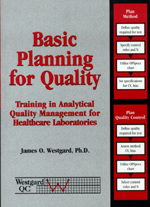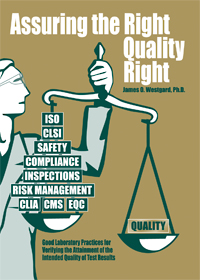Basic Planning for Quality
QP-6: Adopting the OPSpecs Chart as Your Planning Tool
Want to build QC requirements into your quality-planning process? Take method instability into account? Use a quick graphical method? OPSpecs (Operating Specifications) charts are graphical tools does all that and more. All you need to do is figure out if a point is above or below a line. How much simpler can it get? (Preview)
- How to read an OPSpecs chart
- How to determine method performance specifications
- How to select an appropriate QC procedure
- How to assess need for quality improvement
- References
So far, these lessons have focused on the need for quality-planning, based on the lack of independence in past laboratory practices for analytical quality management, the emerging principles of Total Quality Management, and the existing regulatory, accreditation, and QC practice guidelines. A step-by-step quality-planning process has been described drawing on the NCCLS QC practice guidelines. The first step of this process requires definition of the quality required for a test, which can be stated in several different formats - all of which are important in a system of quality standards. The bottom line in the laboratory is knowledge of the operating specifications, which are the imprecision and inaccuracy allowable for a method and the QC needed to monitor method performance and assure the desired quality is achieved.
Operating specifications are different from quality goals or quality standards because they consider QC as an integral part for monitoring the instability of a method, whereas most quality standards generally assume that method performance is stable and therefore don't consider QC. In the lingo of today, this is a paradigm shift - a new perspective or a different view of the situation. QC needs to be designed into the testing process, in addition to analytical imprecision and inaccuracy.
This new perspective provides a more complete and comprehensive view of what is necessary to manage the analytical quality of a laboratory testing process. It's also more complicated because of the interdependence of imprecision, inaccuracy, and QC. The better the imprecision and inaccuracy, the easier it is to QC the process. The worse the imprecision or inaccuracy, the more difficult it becomes to adequately QC the process. The interactions of these three critical factors must be considered.
The best tool for showing these interactions is the chart of operating specifications, or OPSpecs chart. The concept of the OPSpecs chart has been introduced, using the idea of a map that will help you get to solid ground. Example applications of OPSpecs charts have been illustrated for a cholesterol test that has well-defined standards of quality in US national regulations (CLIA-88) and clinical practice guidelines (NCEP). Now is the time to learn the details of how to use OPSpecs charts. For the theory of why it works, see references 1 and 2.

 We invite you to read the rest of this article
We invite you to read the rest of this article
Note: This material is covered in the Basic Planning for Quality manual, which is availalbe in our online store. You can download the Table of Contents and additional chapters here.
Updated and expanded coverage of these topics can be found in Assuring the Right Quality Right,also available in our online store. You can also download the Table of Contents and additional chapters here.
Finally, you can access materials online on these topics by enrolling in the Management and Design of Analytical Quality Systems course course.
